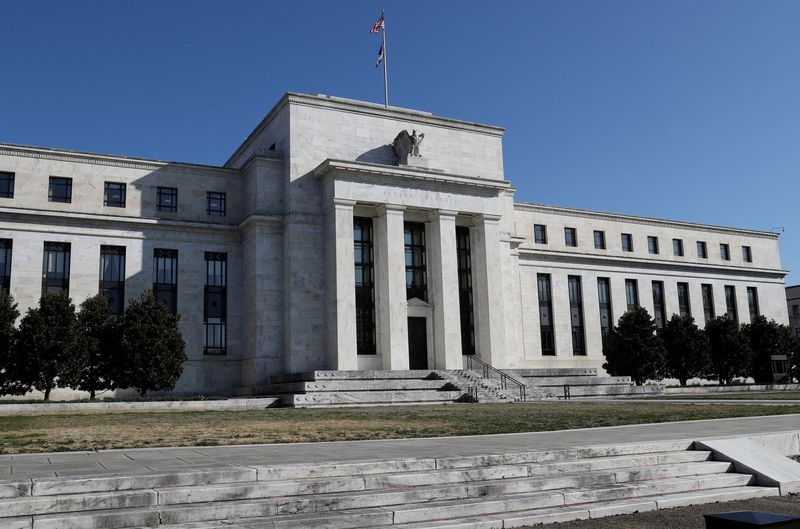Fed forecasts may show fraying faith in soft landing
2022.09.21 09:40
[ad_1]

© Reuters. FILE PHOTO: Federal Reserve Board building on Constitution Avenue is pictured in Washington, U.S., March 19, 2019. REUTERS/Leah Millis/File Photo
By Ann Saphir and Howard Schneider
WASHINGTON (Reuters) – How much faith Federal Reserve officials still have in prospects for a “soft landing” as they take aggressive action to quash the highest inflation in 40 years will be revealed on Wednesday when the central bank releases fresh policymaker forecasts.
The projections from the 19 policymakers, to be published in tandem with the announcement of what is likely to be the Fed’s third straight 75-basis-point interest-rate hike, are not expected to coalesce around a massive jump in unemployment or a contraction of the economy.
Those were the outcomes the last time the Fed, under Paul Volcker’s leadership, battled super-high inflation in the 1980s.
Earlier this month Fed Chair Jerome Powell said he believes that this time around the Fed can avoid such “very high social costs” in part because households and businesses haven’t internalized the kind of inflationary mindset that back then required double-digit interest rates to vanquish.
At the same time, he said, Americans are in for “some pain” ahead as the Fed works to end inflation and prevent what would otherwise be even worse outcomes.
“While the Fed is still likely to view a soft landing as a modal outcome, the window appears to be narrowing,” Bank of America (NYSE:) economists wrote. “Recent Fed communications have acknowledged this, in part, by leaning more strongly in the direction of needing to slow labor markets and accepting the risks to activity that come with it.”
UNEMPLOYMENT FORECAST IN FOCUS
And while the new quarterly summary of policymaker projections may appear to rule out a Volcker-style “hard” landing, it is widely expected to point to notably higher unemployment and slower economic growth in the coming year that by at least one well-known benchmark could signal a recession of some stripe.
That benchmark, known as the Sahm Rule after former Fed staffer Claudia Sahm who identified and formalized it, says the U.S. economy is typically in recession once the 3-month moving average of the unemployment rate rises half a percentage point above the rate’s lowest three-month average over the preceding 12 months. That low currently is around 3.56%.
Economists polled by Reuters expect the unemployment rate to rise to 4.1% by the second quarter of 2023 and to 4.3% by the fourth quarter – far lower than the 14.7% reached in the pandemic crisis or the 10.8% peak during the Volcker recession – but high enough to meet the Sahm Rule test.
Historically once the unemployment rate rises by half a percentage point, it continues to rise another point or two, if not more.
Policymaker projections for the economy hinge on their views of the appropriate setting of monetary policy, a window into which will also be published on Wednesday as part of the Fed’s quarterly summary of economic projections, or SEPs.
This week’s decision is expected to take the Fed policy rate to a range of 3%-3.25% from the current 2.25%-2.50%. The so-called “dot plot” incorporated in the SEPs will indicate each policymaker’s view of where rates should be at the end of each year through 2025.
“We expect the dot plot to show a peak fed funds rate of 4.4% next year, which will push the unemployment rate to near 4.5% over the forecast horizon,” wrote economists at Deutsche Bank (ETR:).
In the most recent forecasts issued in June, the fed funds rate was seen peaking at 3.8% in 2023, with the jobless rate climbing to 4.1% the following year.
RECESSION AHEAD?
Since the dot plot’s advent in 2012, only one policymaker has ever forecast rates to rise that high, and that forecast – in late 2012 and early 2013, for end-of-year 2015 rates to reach 4.5% – turned out to be spectacularly wrong. The Fed instead kept the policy rate at near zero until December 2015, when it lifted it by just a quarter of a percentage point.
This time around, though, financial markets are pricing in a top Fed funds rate of 4.5% next year, with a rate cut or two seen as more than likely toward the second half of 2023.
Wednesday’s projections will also give a read on how quickly Fed policymakers expect their actions to take a bite out of inflation and how much the economy is likely to slow.
In June, inflation was seen remaining above the Fed’s 2% target through 2024, while not even the most pessimistic policymaker expected the economy to contract in coming quarters. Most penciled in gross domestic product growth of between 1.3% and 2% for each of the next three years.
“The new economic projections will highlight the Fed’s pain tolerance with real GDP growth likely to be revised significantly lower,” wrote EY-Parthenon Chief Economist Gregory Daco, adding that the forecast for next year’s unemployment rate could very well exceed 4.5%.
Inflation projections, however, could stick close to those laid out in June, he said, amid “dueling forces from inflation persistence and a more aggressive Fed stance and likely recession.”
[ad_2]
Source link








